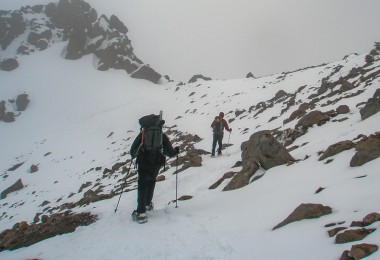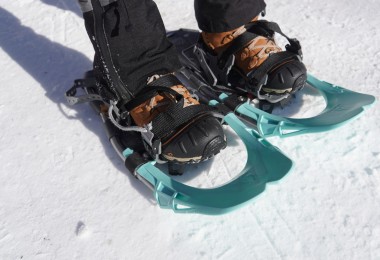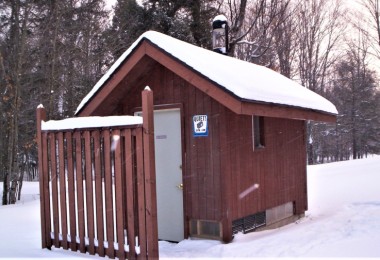Kids, teens, young adults, and parents all seem to enjoy the “what’s in my pack” game. I relay a fictitious story and ask the audience what should be in my pack. Then, I slowly pull out the essential accessories. Since nobody ever says I should carry a snowshoe repair kit, it is always the last item I pull from my daypack when playing this demonstration game. The homemade snowshoe repair kit is often forgotten but incredibly important on the trails.
As part of the game, I point out some scenarios when a repair kit would come in handy. For example, what would you do if one of your bindings broke? You can no longer attach your feet to one of your snowshoes, and you have a foot of snow to travel on to get back to the trailhead a mile away. What if you bridge one of your snowshoes on a log, and your frame (wood or aluminum) breaks in half?
Responses from the audience are always interesting. But the bottom line is that you need supplies available to do field repairs on the trail. Supplies are essential so that you can continue with your snowshoe journey–especially in deep snow. And you would do this by creating and carrying a snowshoe repair kit.
Some of the links in this article may contain affiliate links. When you purchase using these links, part of the proceeds go to Snowshoe Mag. Additionally, as an Amazon Associate, we earn from qualifying purchases. Please see our disclosure for more details.
Anticipate Any Scenarios
To make sure you have all the correct materials in your snowshoe kit, it’s essential to anticipate scenarios and issues that could occur for your specific snowshoes.
Learn about the materials that make up your snowshoes to identify what could potentially go wrong with the shoes. What parts could break? Knowing snowshoe anatomy can help you determine what parts you should make handy in case they do break. Can you get those parts from your snowshoe company?
Whether you have traditional snowshoes made of wood or modern aluminum snowshoes, look at the frame. Rarely do frames break. However, the most common snaps come from bridging a snowshoe on or across a log or rock. What materials could you use to repair this break?
Broken bindings can be a significant problem since the binding’s function is to attach the snowshoe to your foot. Using a fabric strap, webbing, mesh, or other thick material can help temporarily affix the snowshoe to your boot or shoe. This repair involves a combination of creativity and some engineering ingenuity. Take your time, plan, and prepare a solution.
The more you learn about your snowshoes, the better prepared you will be to treat them in the field should something break.
Read More: Definitive Guide: How To Choose the Perfect Snowshoes for Your Needs
Materials You Can Include
Based on the many types of snowshoes that I own, here are the materials I recommend including in your homemade snowshoe repair kit.
Also, make sure you have an easy-to-use carrying case for your items. I use a quart-size heavy-duty zip-lock plastic bag. You can also use a small plastic container with a lid or an old fanny pack. Any of these will work to store your repair supplies.
1. Wire and plastic cable ties or zip-ties
I carry about a dozen 10-inch plastic cable ties and about 3 feet (0.9 m) of aluminum wire. These items can be helpful in many repair situations.
For example, if a Hypalon deck of an aluminum frame shoe tears or breaks away from the frame, you can use either the plastic cable ties or wire to reattach the two together.
You can also use aluminum wire to fix problems or breaks in the snowshoe’s pivot system when in the field.
2. Hose clamp
Like the one you would use to connect a hose in your car or for plumbing, a hose clamp can come in handy. For example, you can use a hose clamp to fix a broken frame by using it to clamp on a tent stake or stick (see below).
3. Metal or substantial aluminum tent stakes
If your snowshoe frame breaks, a temporary field repair method would be creating a splint out of metal or wood using these tent stakes. Then, connect the splint to the remaining frame with a cord, wire, clamp, duct tape, or all of the above.
4. Bootlace or fabric strap with clip, webbing, or mini-bungees
Any of these items can help with a binding repair. The bootlace can also work for attaching decking to a frame, or of course, for replacing a broken lace on your boot.
5. Nuts, bolts, and washers
These items can be convenient for repairing the pivot system on the snowshoe. These systems can be simple or complex, depending on the type of snowshoe. Sometimes, a simple nut and bolt can fix it, depending on the extent of the breakage.
You can also use these items to attach a traction device to a pivot system or deck; or replace a broken rivet on the snowshoe.
6. Duct tape
Canada’s Red Green says that duct tape is the “handyman’s secret weapon.” Using duct tape for most snowshoe field repairs is a way to show you are handy (be you a handyman or handywoman).
Duct tape works well for temporarily mending tears in the deck’s fabric. You can also use duct tape as a temporary fix for a broken binding or frame. You can use Vinyl Mender to repair any tears in snowshoe decking as an alternative to duct tape.
7. Multi-tool or knife with many tool features
One option you can add to your kit is a small multi-tool (like this one), which includes pliers, Phillips, a standard screwdriver, etc. You could also use a Swiss Army knife (like this one) with multiple tool options. These two tool devices will help with repairs that require screwing, tightening, twisting, bending, punching, and cutting.
Read More: 5 Knives That Make a Staunch Companion During Your Snowshoeing Escapades
8. Parts from the snowshoe manufacturer
If available, the last thing to add to your repair kit is any items you can secure from your snowshoe company. Order any auxiliary parts they may sell that would help with field repairs. For example, MSR has a snowshoe maintenance kit that includes clevis pins, split rings, washers, lock nuts, strap retainers, and more. If you own MSR snowshoes, consider adding this to your homemade snowshoe repair kit.
Snowshoe Repair Kit In Action
I once taught a winter backpacking course where students hiked to our campsite using snowshoes. Unfortunately, one of the student’s snowshoe bindings broke away from the frame at the toe hole on their plastic snowshoe.
In my tent that night, I carefully taped the binding to the frame with many wraps of duct tape. Once I got the duct tape to hold onto the two components, I re-wrapped the tape onto itself. This repair held that binding in place through the rest of our trip. I was amazed at the power of duct tape and my repair kit. Red Green would have been proud!
Take your homemade snowshoe repair kit when heading out on the trail for a day of snowshoeing. You should never leave home without it.
Do you have a snowshoe repair kit? What items are in it? How has it helped you?
This article was originally published on April 16, 2013. The article was most recently updated on November 8, 2022.
Read Next: Make Your Own Snowshoes From Scratch









The good, bad, and ugly reasons we have our loving pets. We send you our condolences for your loss. A beloved pet is a joy to have. Our last 5 animals were all adopted from our local animal shelter. Every one of them had a full life with us and had lots of travel time. Our newest one is a great periness breed and she loves the cold and snow. I am a neophyte when it comes to snowshoeing. I hope to walk many miles. I have really enjoyed your newsletter. Oh, by the way I am 70 years young and Crater Lake National Park is my back yard and the Cascade Mountain Range is across the lake from my house. This is the only place to live for me.
Good advice. I shall prepare a kit for this winter.
Thanks, Greg! We hope you have wonderful snowshoeing adventures this winter, and hopefully don’t have any snowshoe repairs 🙂 – Susan
“If they can’t find you handsome, they should at least find you handy.” great show!
I snowshoe on odd terrain alone so much I must have a snowshoe kit like yours with me always.
If I am not camping or not needing tent stakes, I prefer to cut a chunk of semi bendable wood put into the broken frame tube and hose clamp it up with tape underneath.
Besides an outside metal splint I have used an aluminum bendable frame piece from my pack, but that was an extreme circumstance . I also take Gorilla tape to go over the duct tape and make repairs or replacement parts that take a lot of weight bye attaching the tape to itself.
Keep your stick on the ice.